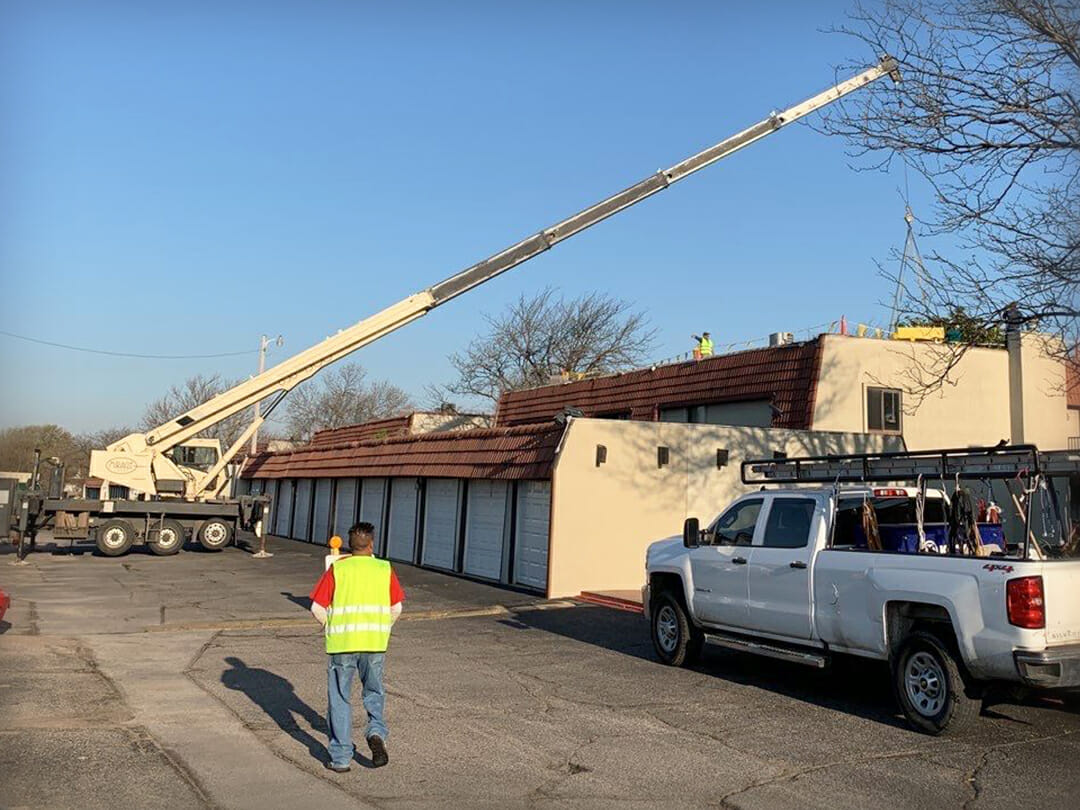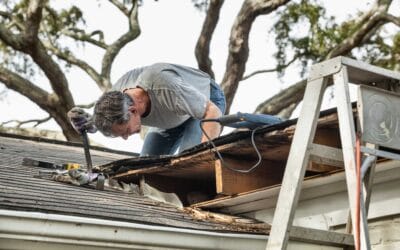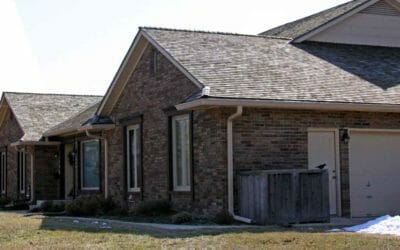Introduction: What to Know About Overhead Work and Equipment
Multi-building complexes, especially tenant-occupied housing/apartments are very different projects than the single-family market served by most roofing companies. Our goal is to arm property managers with a working knowledge of roofing construction to make an educated decision about selecting an appropriate contractor for multi-family and multi-unit properties (especially in residential tenant properties, where safety is extra important).
In general, the roofing industry is primarily focused on single-family residential homes. Put another way, of the total surface area of steep-slope (non-flat) roofing in the United States, most of it is represented by individual homes. The insurance and damage-replacement market for single-family properties is well-served by a robust industry of roofing contractors.
Unfortunately, the ease and relative commoditization of serving the residential market has left the multi-unit and tenant complex market as a secondary focus for most of the industry. At best, this means that it is a challenge to find appropriate contractors – at worst, this means that many residential roofers are bidding and attempting larger commercial jobs without the proper capacity, equipment, and experience to handle the jobs safely.
For property managers, understanding construction equipment is one tangible way of evaluating (or comparing) the capability of a roofing contractor. In response to customer questions over the years, we have put together this guide to arm property managers with the right questions to ask during the evaluation and preparation process.
We have detailed some of the most important things to know about the extra steps, special tools, and equipment used in multifamily roofing. You can expect that a quality multifamily roofing contractor will incorporate these into their normal course of business:
Safety Equipment
Safety requirements are heightened in multifamily projects due to taller buildings and the presence of tenants. There is a reason we are listing safety equipment first; it is a non-negotiable.
- Doorway Coverings/Overhead Protection: Scaffolding or other overhead barriers can direct people to walk in limited paths and protect from overhead debris for entryways that must remain in-use during construction
- Scaffolds: Used for access to elevated areas and ensuring worker safety.
- Property Protection Equipment: See below
- Site control Equipment: See below
Note that essentially all the equipment used in overhead work ties back to safety of those working and those in the area.
Site Control Equipment
Maintaining order on-site is essential to safety and prevention. Equipment may include:
- Stanchions: Used to create designated work zones and restrict tenant access to hazardous areas or temporarily closed building entries.
- Signage: Clearly communicating safety instructions and warnings.
- Cones: Marking off areas and hazards to ensure tenant safety.
- Flagging and Road Closures: Parking and area controls are needed for the scale of overhead projects done on multifamily properties.
Loading and Access Equipment
The added height of most multifamily buildings demands different equipment. Efficient loading and access equipment ensure smooth project execution:
- Conveyor Loaders: Material delivery onto taller buildings is a challenge. OHSA regulations limit hand-loading, especially on taller buildings, which requires conveyors for materials access and loading
- Cranes: Cranes are needed for delivery outside conveyor limits (usually 4+ story buildings), or are frequently used for flat roofing materials, which have much larger package sizes for delivery. Any job with a ballast roof (rock/gravel) will typically also require a crane.
- Telehandlers: These are forklift-style loaders but with a much greater boom arm reach

A hydraulic lift trailer (Equipter) and telehandler in use at a condo complex roofing project. These can be used to contain trash and debris during tear-off so that it doesn’t fall to the ground, or for loading materials during construction. Also note the cargo nets on the ground to make cleanup easy – these nets can be hung over landscaping, windows, or HVAC units. Rhoden Roofing.

A crane was needed at this apartment complex both because of the loading access over the garage row and to deliver material/haul debris off the flat roof. Note the mix of roof types with the mansards, which were replaced after the flat roof sections. Multifamily projects often have mixed roof types. Rhoden Roofing.
Property Protection Equipment
Protecting tenant property is crucial to avoid damage during roofing projects. Consider:
- Lift Trailers or Elevated Trash Buckets: Lift trailers, such as Equipter brand trailers, or trash buckets on a telehandler, allow tear-off debris to get contained at the roofline rather than falling. On a multistory building, even a light breeze can push debris through someone’s window on the way down.
- Coverings: For tenant belongings, patios or balconies, shielding them from dust and debris. Fine-mesh but durable cargo netting, such as Catch-All nets, protect landscaping while allowing the plants to breathe or “burn” if excess heat is trapped underneath, as happens with tarps.
- AC/HVAC Protection: Ground units will require protection, and rooftop units extra handling. Netting, or wood structures like oversized sawhorses and OSB, can protect equipment while still allowing it to run. This topic is such a critical component of making a project go successfully that we published a separate guide just on Planning and Protecting AC/HVAC Units During Multifamily Roofing.
Inspection Equipment
Proper inspection equipment is essential for thorough assessments of roofing conditions. These may include:
- Drones: Used for aerial surveys, condition reports, viewing inaccessible areas like the tops of chimneys or mansard roof sections. Buildings that are 3+ stories tall get the most benefit from drone inspections, as do properties with many buildings, as what used to take 1-days to inspect now can be done in a few hours. See much more detail at Why Do Roofing Companies Use Drones?
- Thermal Cameras: To detect hidden issues, such as leaks or insulation problems. These can also get information about large areas at a time, which is important in large complexes. Read more about Using Thermal Imaging to Detect Leaks
- Microscopes: Sometimes necessary for close examinations of roofing materials. Field microscopes are available relatively cheaply, and connect to a cell phone for display monitoring.
- Additional Ladders and Safety Gear: Vital for multifamily properties with varying building heights.
Flat Roofing Capability Equipment (If Applicable)
Multifamily properties often have mixed roofing types, including flat sections and AC platforms, requiring contractors with diverse capabilities. A contractor who only does steep-slope (e.g. shingles) is going to run into problems with any flat sections on your property – AC platforms, warehousing or storage buildings, carports, etc. Rollers, heat torches, custom caps and flashing, and pitch pockets are examples of flat roofing tools & components.
Gutters vs scuppers. Remember that roof systems aren’t just about what’s on the surface. If you have a flat roof with a scupper system that needs work, it will require special expertise and attention.
If your property has multiple roof types, make sure your contractor is fluent in each. Sections of flat roofing are most common on multifamily properties, but this could be true of metal carports, a tile clubhouse/pool house, etc. Transition sites from one roof type to another tend to generate the most problems for leaks and repairs needed later, which makes this topic extra important anywhere two roof types meet.
Gutter Equipment
Multi-unit buildings can have extra long gutter runs or additional gutter needs. Consider the need for specialized equipment for gutter installation and maintenance:
- Gutter Roll Former: For installation of seamless gutters, which can cover much longer linear runs without risk of coming apart or requiring maintenance. The upper boundary for a single seamless gutter is about 150 feet.
- Extra Long Ladders: The increased roof height of most apartment buildings provide even more of a challenge during gutter installation, which is completed both from above and below.
- Bucket or Scissor Lifts: In extreme cases, the gutter-line and fascia of a building are only accessible via hydraulic lifts. Gutter work tends to encounter the most challenge from access limited by AC/HVAC bays (see our article on HVAC Planning/Protection for Multifamily Roofing Projects), which can necessitate bucket lifts to get over the clear area.
Cleanup Equipment
Efficient cleanup mostly comes down to preventing a mess in the first place (see property protection equipment above). However, some basic equipment and steps keep the property clean and tenants happy.
- Property Protection Equipment: As detailed above; trash containers, lift trailers, cargo netting, all help to collect and remove debris promptly.
- Roller Magnets (Magnetic Sweepers): Ensuring nails and metal debris are thoroughly cleaned up before a tenant calls because of a popped tire.
- Compressors and Brooms: Don’t forget the basics – blowing dust off balconies and tenant property like grills is the way to go the extra mile (we consider this the “expected mil”) and keep tenants happy.
- Pressure washers: Sometimes, if heavy equipment is used like conveyor trucks, telehandlers, or crane trucks, tire marks are left on pedestrian walkways. Power washing can take care of this and the reminders of construction you don’t want around for your tenants to see as soon as the project is completed.
Conclusion: The Three Pillars of Tenant Safety
Everything comes back to tenant safety and tenant experience.
- Effective Setup and Pre-planning: The initial setup is critical. Communication, safety cones, caution tape, and clear signs to indicate ongoing construction.
- Proper Equipment Usage: Being armed with the right equipment can significantly reduce risks. In multi-story properties especially, overhead work needs specialized equipment to manage debris safely.
- On-site Production Manager: Having an on-site production manager dedicated to safety is invaluable. That person can oversee the crews, watch for potential hazards, and promptly address any issues that arise.
Prioritizing tenant safety during multifamily roofing projects is non-negotiable. Safety is a shared responsibility, and these practices ensure a successful roofing project while keeping everyone safe. Ask plenty of questions to your prospective contractor to make sure priorities are aligned.
If your property is in the lower Midwest region, Rhoden Roofing is here to help. Our team has been serving the multifamily roofing market since 2008, and we offer free routine inspections across Kansas, Oklahoma, Missouri, and Arkansas.
This article is part of our Multifamily Roofing Comprehensive Planning Guide. Learn more about:
- Ensuring Smooth Projects
- Know Before You Start
- Common Challenge Areas
- Related Education



